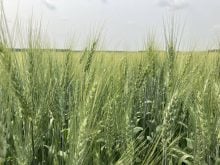Marc Durand should net a tidy profit from his 210 acres of buckwheat if the weather is just right this summer.
Prices for the specialty crop are at “unprecedented levels” of around $15 per acre.
Durand, who typically seeds 160 to 300 acres on his farm near Notre Dame, Man., knows he can reap profits because he has grown buckwheat crops that yielded 40 bushels per acre.
“At 45 bushels per acre and $15 per bu., there’s money to be made there,” said Durand.
Read Also

Why feds imposed EV tariffs
Moe and Kinew have a fight on their hands when it comes to eliminating the EV tariff. Canada has to worry about pissing off the U.S. and Mexico and hundreds of thousands of auto workers.
Prices aren’t always that high. Buckwheat was $12 per bu. last year and has traded around $8 per bu. in the recent past.
However, Manitoba Agriculture buckwheat specialist Rejean Picard expects acres in the province to be similar to 2009 and 2010.
“Talking to the seed suppliers and the processors, it might be … around 4,500 acres,” said Picard.
Official acreage statistics are pending.
Manitoba growers planted 30,000 acres of buckwheat 10 years ago, but acreage shrank during the 2000s to the point where Picard said the crop is now in survival mode.
“With the last two or three years being below 5,000 acres, it’s really not enough for the industry to survive.”
It won’t be because of lack of demand if Manitoba growers stop planting the crop entirely. Processors from around the world regularly call Durand, who owns and operates Durand Seeds, to ask about his buckwheat crop or seed.
Japan remains the largest customer for Canadian buckwheat. The Japanese use it to make soba noodles, which are often served cold in the summer months.
Yet, like other specialty crops, buckwheat acres have dwindled because farmers can generate higher profits growing canola.
“As long as the price is not as good, or not able to compete with other crops in terms of net revenue per acre, that’s what has been the problem (with buckwheat) the last 10 years,” Picard said.
Durand said buckwheat acres in Manitoba are unlikely to rebound to 20,000 or 30,000 a year, but he doesn’t think the crop will vanish from the landscape.
In his case, he grows buckwheat because it offers an opportunity to make money from his farm’s marginal, sandy land.
“We’re not putting much into it and if we get something out of it, great. But if you put canola on that land and throw a whole pile of inputs on it and don’t get a high yield, you’re not making a whole pile of money.”
Buckwheat is tricky to grow, with potential yields varying from five to 40 bu. per acre.
“In some years you think it’s a good buckwheat year and there’s no yield. And other years it doesn’t look like a good buckwheat year, and you get high yields,” Durand said.
“It needs a period of stress during the summer … which encourages the plant to set seed and reproduce for next year.”
Durand is encouraged by news out of Saskatchewan, where growers are trying buckwheat.
“I think Saskatchewan buckwheat acres must be going up every year. I know a lot of organic farmers grow buckwheat. Either they grow it for grain or it’s a great green manure for them, for phosphates.”
Canadian Organic Growers says farmers in Canada planted 771 acres of certified organic buckwheat in 2008 and 1,029 acres in 2009.
Chantal Jacobs, an organic crop specialist with Saskatchewan Agriculture, said she hasn’t heard that organic producers are planting more acres of buckwheat in the province. Most organic producers plant peas and lentils to add nitrogen to the soil, she added.
“I know the research shows that it is good for greenfeed, but it isn’t a legume and we still like to get those nitrogen fixing crops in the ground.”
Buckwheat Facts
Phosphorus scavenger:
•Aside from producing grain and providing nectar for bees, buckwheat also requires less nitrogen than other crops and is able to retrieve phosphorus locked in the soil. Its roots produce mild acids that release nutrients from the soil and activate slow-releasing organic fertilizers, such as rock phosphate. When the plant breaks down, it releases phosphorus for the next crop.
Thrives in poor soil:
•Buckwheat performs better on low-fertility soil and soil with high levels of decaying organic matter. That’s why it was often the first crop planted on cleared land during the settlement of woodland areas and is still a good crop for rejuvenating over-farmed soils.
Source: Sustainable Ag Research &Education
———
access=subscriber section=news, crops, none















